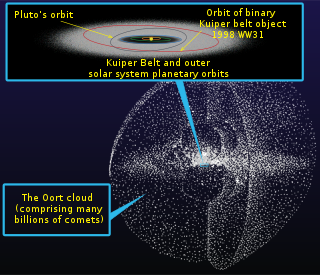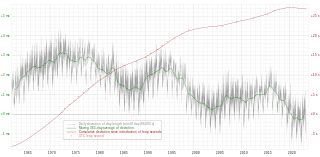International Atomic Time is a high-precision atomic coordinate time standard based on the notional passage of proper time on Earth's geoid. TAI is a weighted average of the time kept by over 450 atomic clocks in over 80 national laboratories worldwide. It is a continuous scale of time, without leap seconds, and it is the principal realisation of Terrestrial Time. It is the basis for Coordinated Universal Time (UTC), which is used for civil timekeeping all over the Earth's surface and which has leap seconds.

The astronomical unit is a unit of length, roughly the distance from Earth to the Sun and approximately equal to 150 million kilometres or 8.3 light-minutes. The actual distance from Earth to the Sun varies by about 3% as Earth orbits the Sun, from a maximum (aphelion) to a minimum (perihelion) and back again once each year. The astronomical unit was originally conceived as the average of Earth's aphelion and perihelion; however, since 2012 it has been defined as exactly 149597870700 m.
The term ephemeris time can in principle refer to time in association with any ephemeris. In practice it has been used more specifically to refer to:
- a former standard astronomical time scale adopted in 1952 by the IAU, and superseded during the 1970s. This time scale was proposed in 1948, to overcome the disadvantages of irregularly fluctuating mean solar time. The intent was to define a uniform time based on Newtonian theory. Ephemeris time was a first application of the concept of a dynamical time scale, in which the time and time scale are defined implicitly, inferred from the observed position of an astronomical object via the dynamical theory of its motion.
- a modern relativistic coordinate time scale, implemented by the JPL ephemeris time argument Teph, in a series of numerically integrated Development Ephemerides. Among them is the DE405 ephemeris in widespread current use. The time scale represented by Teph is closely related to, but distinct from, the TCB time scale currently adopted as a standard by the IAU.

In physics, spacetime is any mathematical model that fuses the three dimensions of space and the one dimension of time into a single four-dimensional continuum. Spacetime diagrams are useful in visualizing and understanding relativistic effects such as how different observers perceive where and when events occur.

The theory of relativity usually encompasses two interrelated physics theories by Albert Einstein: special relativity and general relativity, proposed and published in 1905 and 1915, respectively. Special relativity applies to all physical phenomena in the absence of gravity. General relativity explains the law of gravitation and its relation to the forces of nature. It applies to the cosmological and astrophysical realm, including astronomy.
Terrestrial Time (TT) is a modern astronomical time standard defined by the International Astronomical Union, primarily for time-measurements of astronomical observations made from the surface of Earth. For example, the Astronomical Almanac uses TT for its tables of positions (ephemerides) of the Sun, Moon and planets as seen from Earth. In this role, TT continues Terrestrial Dynamical Time, which succeeded ephemeris time (ET). TT shares the original purpose for which ET was designed, to be free of the irregularities in the rotation of Earth.
A time standard is a specification for measuring time: either the rate at which time passes or points in time or both. In modern times, several time specifications have been officially recognized as standards, where formerly they were matters of custom and practice. An example of a kind of time standard can be a time scale, specifying a method for measuring divisions of time. A standard for civil time can specify both time intervals and time-of-day.
In standard cosmology, comoving distance and proper distance are two closely related distance measures used by cosmologists to define distances between objects. Comoving distance factors out the expansion of the universe, giving a distance that does not change in time due to the expansion of space. Proper distance roughly corresponds to where a distant object would be at a specific moment of cosmological time, which can change over time due to the expansion of the universe. Comoving distance and proper distance are defined to be equal at the present time. At other times, the Universe's expansion results in the proper distance changing, while the comoving distance remains constant.
Time dilation is the difference in elapsed time as measured by two clocks, either due to a relative velocity between them, or a difference in gravitational potential between their locations. When unspecified, "time dilation" usually refers to the effect due to velocity.
Barycentric Dynamical Time is a relativistic coordinate time scale, intended for astronomical use as a time standard to take account of time dilation when calculating orbits and astronomical ephemerides of planets, asteroids, comets and interplanetary spacecraft in the Solar System. TDB is now defined as a linear scaling of Barycentric Coordinate Time (TCB). A feature that distinguishes TDB from TCB is that TDB, when observed from the Earth's surface, has a difference from Terrestrial Time (TT) that is about as small as can be practically arranged with consistent definition: the differences are mainly periodic, and overall will remain at less than 2 milliseconds for several millennia.
Barycentric Coordinate Time is a coordinate time standard intended to be used as the independent variable of time for all calculations pertaining to orbits of planets, asteroids, comets, and interplanetary spacecraft in the Solar System. It is equivalent to the proper time experienced by a clock at rest in a coordinate frame co-moving with the barycenter of the Solar System: that is, a clock that performs exactly the same movements as the Solar System but is outside the system's gravity well. It is therefore not influenced by the gravitational time dilation caused by the Sun and the rest of the system. TCB is the time coordinate for the Barycentric Celestial Reference System (BCRS).
Geocentric Coordinate Time is a coordinate time standard intended to be used as the independent variable of time for all calculations pertaining to precession, nutation, the Moon, and artificial satellites of the Earth. It is equivalent to the proper time experienced by a clock at rest in a coordinate frame co-moving with the center of the Earth: that is, a clock that performs exactly the same movements as the Earth but is outside the Earth's gravity well. It is therefore not influenced by the gravitational time dilation caused by the Earth. The TCG is the time coordinate for the Geocentric Celestial Reference System (GCRS).
The astronomical system of units, formerly called the IAU (1976) System of Astronomical Constants, is a system of measurement developed for use in astronomy. It was adopted by the International Astronomical Union (IAU) in 1976 via Resolution No. 1, and has been significantly updated in 1994 and 2009.
Gravitational time dilation is a form of time dilation, an actual difference of elapsed time between two events as measured by observers situated at varying distances from a gravitating mass. The lower the gravitational potential, the slower time passes, speeding up as the gravitational potential increases. Albert Einstein originally predicted this effect in his theory of relativity and it has since been confirmed by tests of general relativity.
An astronomical constant is any of several physical constants used in astronomy. Formal sets of constants, along with recommended values, have been defined by the International Astronomical Union (IAU) several times: in 1964 and in 1976. In 2009 the IAU adopted a new current set, and recognizing that new observations and techniques continuously provide better values for these constants, they decided to not fix these values, but have the Working Group on Numerical Standards continuously maintain a set of Current Best Estimates. The set of constants is widely reproduced in publications such as the Astronomical Almanac of the United States Naval Observatory and HM Nautical Almanac Office.

Theoretical astronomy is the use of analytical and computational models based on principles from physics and chemistry to describe and explain astronomical objects and astronomical phenomena. Theorists in astronomy endeavor to create theoretical models and from the results predict observational consequences of those models. The observation of a phenomenon predicted by a model allows astronomers to select between several alternate or conflicting models as the one best able to describe the phenomena.

In time standards, dynamical time is the independent variable of the equations of celestial mechanics. This is in contrast to time scales such as mean solar time which are based on how far the earth has turned. Since Earth's rotation is not constant, using a time scale based on it for calculating the positions of heavenly objects gives errors. Dynamical time can be inferred from the observed position of an astronomical object via a theory of its motion. A first application of this concept of dynamical time was the definition of the ephemeris time scale (ET).

In physics, time is defined by its measurement: time is what a clock reads. In classical, non-relativistic physics, it is a scalar quantity and, like length, mass, and charge, is usually described as a fundamental quantity. Time can be combined mathematically with other physical quantities to derive other concepts such as motion, kinetic energy and time-dependent fields. Timekeeping is a complex of technological and scientific issues, and part of the foundation of recordkeeping.
When using the term "the speed of light" it is sometimes necessary to make the distinction between its one-way speed and its two-way speed. The "one-way" speed of light, from a source to a detector, cannot be measured independently of a convention as to how to synchronize the clocks at the source and the detector. What can however be experimentally measured is the round-trip speed from the source to a mirror and back again to detector. Albert Einstein chose a synchronization convention that made the one-way speed equal to the two-way speed. The constancy of the one-way speed in any given inertial frame is the basis of his special theory of relativity, although all experimentally verifiable predictions of this theory do not depend on that convention.
The barycentric celestial reference system (BCRS) is a coordinate system used in astrometry to specify the location and motions of astronomical objects. It was created in 2000 by the International Astronomical Union (IAU) to be the global standard reference system for objects located outside the gravitational vicinity of Earth: planets, moons, and other Solar System bodies, stars and other objects in the Milky Way galaxy, and extra-galactic objects.













